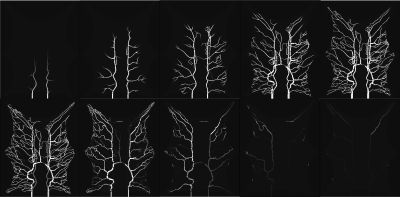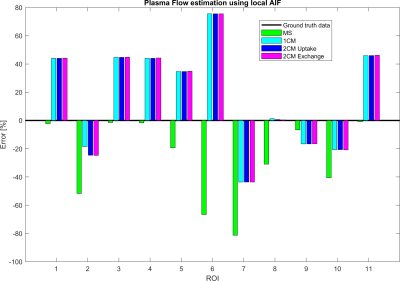Ulin Nuha Abdul Qohar1, Erik Andreas Hanson1, Steven Sourbron2, and Antonella Zanna Munthe-Kaas1
1Mathematics, University of Bergen, Bergen, Norway, 2University of Sheffield, Sheffield, United Kingdom
1Mathematics, University of Bergen, Bergen, Norway, 2University of Sheffield, Sheffield, United Kingdom
CFD generated perfusion MRI data was used for evaluation and comparison of tracer kinetic models. The proposed framework provides suitable ground truth data as a digital reference data to study the elusive problem of model bias in more deeply than was previously possible.

Simulated CA flow in the vascular system after bolus injection. The flow patterns exhibit a natural behaviour with a flow from the arterial network roots feeding the whole vasculature, spreading to the capillaries and a washout through the veins. The images were captured at 6, 8, 10, 15, 20, 25, 35, 50, 70 and 100 second respectively (from left to right).

Plasma flow (PF) estimation results using four tracer kinetic models in 11 ROIs. The MS model is systematically underestimating PF, but generate the best estimation among the four models in terms of absolute values. The remaining models are, in general, overestimating PF and generate close to identical values, except for ROI 2. This reveals that the 2-compartment models are over-parameterized and not suited for estimations in our CA flow phantom. The proposed flow model only accounts for blood circulation in the intravascular structures.
